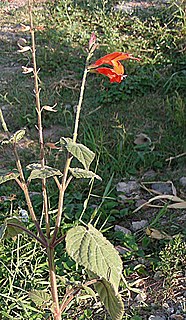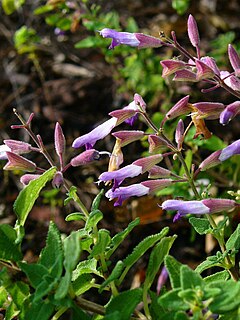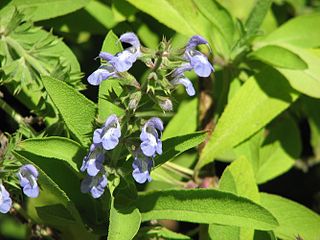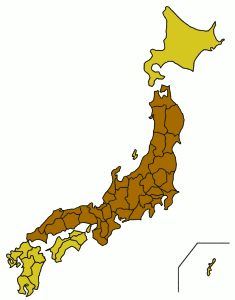
Salvia officinalis is a perennial, evergreen subshrub, with woody stems, grayish leaves, and blue to purplish flowers. It is a member of the mint family Lamiaceae and native to the Mediterranean region, though it has naturalized in many places throughout the world. It has a long history of medicinal and culinary use, and in modern times as an ornamental garden plant. The common name "sage" is also used for a number of related and unrelated species.

Salvia sclarea, the clary or clary sage, is a biennial or short-lived herbaceous perennial in the genus Salvia. It is native to the northern Mediterranean Basin, along with some areas in north Africa and Central Asia. The plant has a lengthy history as a medicinal herb, and is currently grown for its essential oil.

Salvia argentea, the silver sage, silver salvia, or silver clary, is a biennial or short-lived perennial plant that is native to an area in southern Europe from Portugal to Bulgaria. Its specific epithet, argentea, refers to the silvery leaves.

Salvia spathacea, the California hummingbird sage, hummingbird sage, or pitcher sage, is a species of flowering plant in the family Lamiaceae, native to southern and central California growing from sea level to 610 m (2,001 ft). This fruity scented sage blooms in March to May with typically dark rose-lilac colored flowers. It is cultivated in gardens for its attractive flowering spikes and pleasant scent.

Salvia glutinosa is a herbaceous perennial plant belonging to the Lamiaceae family.

Salvia greggii is a herbaceous perennial native to a long, narrow area from southwest Texas, through the Chihuahuan Desert and into the Mexican state of San Luis Potosi, typically growing in rocky soils at elevations from 5,000 to 9,000 ft. It was named and described in 1870 by botanist Asa Gray after Josiah Gregg, a merchant, explorer, naturalist, and author of the American Southwest and Northern Mexico who found and collected the plant in Texas. It is closely related to and frequently hybridizes with Salvia microphylla. Contrary to its common name, it blooms throughout the summer and autumn.
Salvia sprucei is a herbaceous perennial in the Lamiaceae family that is native to Ecuador, growing at 7,000 feet (2,100 m) elevation or higher in thick scrub on steep slopes. It was named in 1898 by botanist John Isaac Briquet for the British plant collector Richard Spruce. It is likely that Spruce discovered the plant on a collecting trip in Ecuador in 1857.

Salvia microphylla, the baby sage, Graham's sage, or blackcurrant sage, is an evergreen shrub found in the wild in southeastern Arizona and the mountains of eastern, western, and southern Mexico. It is a very complex species which easily hybridizes, resulting in numerous hybrids and cultivars brought into horticulture since the 1990s. The specific epithet microphylla, from the Greek, means "small leaved". In Mexico, it is called "mirto de montes," or "myrtle of the mountains."
Salvia candidissima is a herbaceous perennial native throughout western Greece, and parts of Turkey, Iraq, and Iran, generally between 2000 and 6500 feet elevation. Several small stems grow almost horizontally from the roots before bearing upright inflorescences. The plant reaches 3 ft in height and width in the wild. The light green leaves, 6 in long by 4 in wide, are covered with hairs on both sides and often have notches on the edges. The leaves become lighter in color as the weather gets hotter. The 8–12 inch inflorescences are branched, with 1 inch flowers in whorls that are creamy white and sometimes tipped with a yellow lip. Salvia candidissima is one of a group of seven salvias that are closely related, grow in the same habitat, and easily hybridize with each other, resulting in a great deal of variety in the species.

Salvia confertiflora is a herbaceous perennial shrub native to Brazil that will reach 4–6 feet in height and width in one season. It has been used in horticulture in the United States since the 1960s, although it isn't commonly sold at nurseries because of its large size. The dark green leaves, with a yellow undertone, are about 7 inches long by 3.5 inches wide, with serrated edges, and with velvety red-brown hairs on the petiole and stem of the new leaves.

Salvia gesneriflora is a herbaceous perennial or subshrub native to mountainous provinces of the Sierra Madre Oriental in Mexico, growing at 7,500–10,000 ft elevation. It was named for Gesneria-like flower.The genus Gesneria is named in honor of 15th-century Swiss botanist Conrad Gessner. The long tubular flowers of this salvia resemble Gesneria flowers. It is a popular ornamental plant.
Salvia namaensis is an evergreen perennial shrub native to a limited area in Namibia and a wide area of South Africa. It is typically found growing on rocky slopes, shales, limestone hills, and sandy soils at 1,000 to 5,000 feet elevation. The specific epithet namaensis probably refers to the Nama tribe which is indigenous to Namaqualand, the region in Namibia where the plant grows.

Salvia oppositiflora is a perennial native to Peru, growing at high elevations—7,000 to 12,000 feet. It was collected in 1798 by Hipólito Ruiz López and José Antonio Pavón Jiménez and later described in Flora of Peru.

Salvia sagittata is a herbaceous perennial plant that is native to the Andes Mountains, growing at elevations from 9,500 to 10,500 ft. The specific epithet refers to the arrow-shaped leaves. The plant was collected and named in 1798 by Hipólito Ruiz López and José Antonio Pavón Jiménez, two Spanish botanists who spent ten years in Peru and Chile on a commission by the government of Spain to go to the New World in search of new medicinal and agricultural plants.

Salvia scabra is a herbaceous perennial native to the southeastern strand of the Cape of Good Hope in South Africa, growing on sandy shores, coastal brush, and hilly slopes up to an elevation of 600 feet. It was described and named by Carl Linnaeus in 1781. The leaves and an extract from the roots have been used medicinally in its native region for at least one hundred years. Salvia scabra was introduced to California gardens around 1996, and is extremely adaptable to many types of conditions. Since then it has spread to gardens in England, France, and Italy.

Salvia semiatrata is a perennial native to the Sierra Madre del Sur in the Mexican state of Oaxaca, growing at elevations of 6,500 ft (2,000 m) or higher. It prefers the edges of pine forests, and is also found on limestone cliffs and banks and in cactus scrub habitats that are dry and exposed.

Salvia somalensis is a perennial shrub endemic to a limited range and elevation in Somalia. It grows at elevations from 4,000 feet (1,200 m) to 7,000 feet (2,100 m), typically in forest clearings or edges as a common or dominant subshrub.
Salvia taraxacifolia is a herbaceous perennial shrub that is native only to southwest Morocco, growing in the Atlas Mountains at elevations ranging from 2,000 feet (610 m) to 8,000 feet (2,400 m). Very adaptable, it grows on limestone slopes, forest clearings, and rocky riversides. It has no close allies in the genus Salvia. The specific epithet, taraxacifolia, is likely Persian in origin and means 'leaves shaped like a dandelion'.
Salvia tubiflora is a perennial native to a small area of western Peru and northern Chile near the tropic of Capricorn, growing at elevations from 800 feet (240 m) to 1,600 feet (490 m).

Salvia canescens, the hoary sage, is a herbaceous perennial that is endemic to the Caucasus mountains. The specific epithet, canescens, refers to the off-white hairs covering the leaves.



















